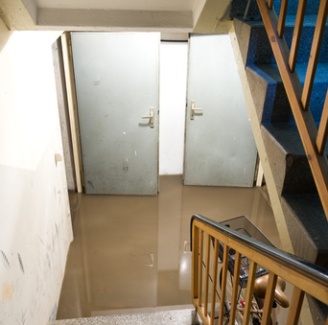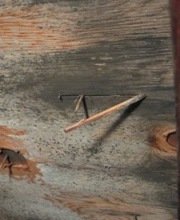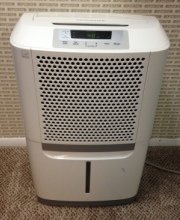Find a Mold Specialist Now
Click or Call, Toll-Free 24/7
Basement Flood Cleanup
Basement flood cleanup can be a very big job. The amount of work involved, and the extent of the damage, will depend on the size of your basement, the amount of water in your basement (a few inches of water does much less damage than several feet of water), what was stored in your basement, and whether the water may have been contaminated with sewage or other hazardous substances. Dealing with a couple inches of rain water in your basement is much different, and much easier, than dealing with something like post-hurricane flooding in which the entire basement has been submerged, possibly for several days.
Of course, if you’ve been subject to an actual flood, more than your basement may be affected. You can follow this link to learn more about flood damage cleanup.
Safety First

If your basement has been flooded as a result of a storm or other natural disaster or if your entire home has been submerged, you need to make sure it’s safe to enter the home before beginning the basement flood cleanup process. You need to make sure the building is structurally sound. In addition, the electricity should be shut off until an electrician confirms it is safe to use. Be aware of the possibility of wildlife in the basement after a storm-related flood, as well as the possibility that the flood water may have been contaminated with sewage or other hazardous substances. Don’t wade into flood water, as you may be injured by unseen debris.
If there is any question about whether it is safe to enter your basement, call in a professional to assess the situation first.
While cleaning up your basement, be sure to wear protective gear. The gear you’ll need will depend on the condition of your basement, but might include boots to protect your feet, disposable gloves to protect against bacteria, mold and other hazardous substances that may have been in the flood water, and an N-95 respiratory mask (available at any hardware store) to protect against the inhalation of dust, mold spores or other microscopic debris.
Removing Water from Your Basement
Before you can begin the basement flood cleanup, the water must be removed from your basement. You may be thinking you want to get that water out of there as quickly as possible in order to try to salvage things in the basement, like carpet, drywall, furniture and stored items. Unfortunately, many of those things will not be salvageable, no matter what you do, and if you’ve got more than a couple feet of water in your basement, removing the water too quickly can actually make matters worse.
If you have to pump water out of your basement, it should be done gradually, only two or three feet of water per day. More than that results in a rapid change of pressure against the basement walls, which can cause the walls to crack. Rapidly changing pressure can also damage the floor and ceiling of the basement.
Most homeowners will need to call in a professional to pump the water out of their basements because most homeowners don’t have that kind of equipment readily available. If you have flood insurance, your insurance policy should cover the cost. Contact your insurance agent of you have questions about your policy.
After the Water Recedes
Once the water is out of your basement, the real work can begin. You’ll need to remove and discard any debris as well as any broke items or soiled items that cannot be adequately cleaned. Unfortunately, many materials cannot be adequately cleaned if they’ve been submerged for more than a very brief time and are likely to become moldy, even if you do your best to clean them.
The following materials will probably need to be removed and replaced if they’ve been submerged, especially if they’ve been underwater for more than 48 hours:
- Books, papers and photographs
- Drywall
- Carpet
- The padding beneath carpet
- Mattresses
- Upholstered furniture
If items have been submerged for more than 48 hours, mold may have begun to grow, even if you can’t see any mold yet. Therefore, it’s recommended that you enclose waterlogged materials in heavy plastic bags before carrying them through the house to discard them, to make sure you don’t inadvertently spread mold spores throughout the home.
The National Archives offers some tips for salvaging papers and photographs. If you have important papers or photographs that were damaged by flooding, you should contact a professional conservator for assistance.
Sometimes carpet can be saved, if you can dry it quickly with the help of dehumidification and water extraction equipment. After it’s dry, vacuum the carpet with a vacuum equipped with a HEPA filter to remove any bacteria or mold. The padding beneath the carpet should be discarded and replaced, as it is not possible to clean that adequately.
Mattresses, couch cushions and similar items can take a very long time to dry and cannot be cleaned adequately, so those must be disposed of and replaced.
Concrete, glass, metal and other nonporous materials can generally be cleaned by scrubbing them with an antimicrobial cleaner. You can read about some of the products available here. We recommend using a product that kills bacteria as well as mold.
If you’re not sure if an item can be saved or how to properly clean something, we recommend consulting a professional for advice.
For Help with Basement Flood Cleanup
For help with basement flood damage cleanup, consult a professional water damage contractor. Note that the U.S. Environmental Protection Agency (EPA) recommends calling in a professional after a significant flood due to the many safety concerns. As mentioned previously, if you have flood insurance, your insurance policy should cover the cost (and if you don’t have flood insurance but live in an area prone to flooding, we suggest contacting your insurance agent to talk about your coverage). To find experienced water damage contractors in your area, just follow the link.
Return From Basement Flood Cleanup To Our Main Water Damage Page
Privacy Policy Terms and Conditions Accessibility Do Not Sell My Information Disclaimer Contact Us




